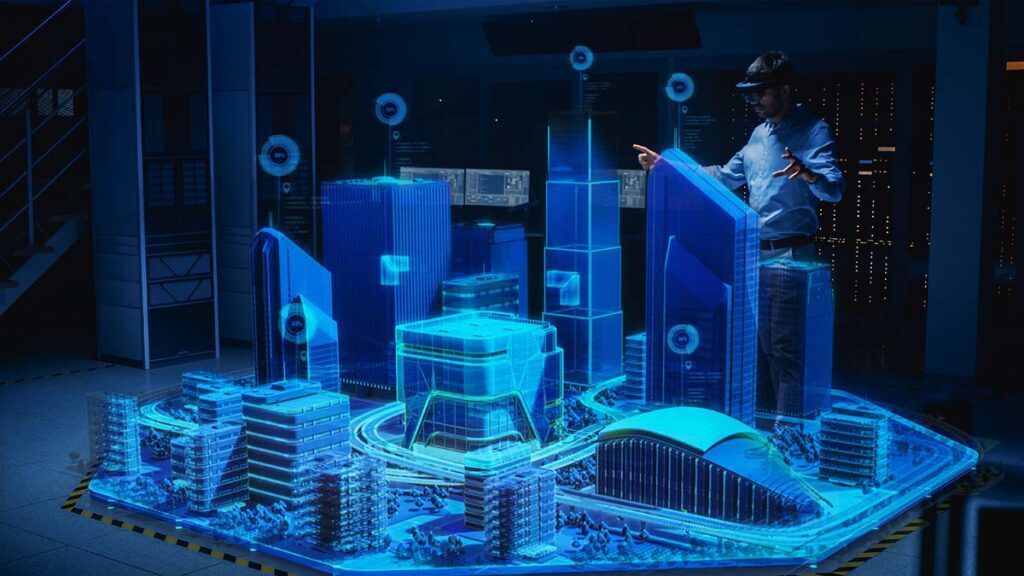
How can augmented reality be used in the construction industry, a field that has maintained relatively similar technology over the past decades? 3D printing and modular building are new trends in some types of construction, but what does the application of augmented reality in construction look like?
In a world of rapid digital transformation and technological innovation, no industry is safe from disruption. Construction on the other hand has had a more linear advancement, with incremental improvements implemented as soon as they are invented.
Augmented reality, or AR, is a fast-evolving technology with adoption and integration increasing exponentially across many industries. Could the use of visualized digital imagery overlayed on the physical surroundings benefit construction engineers?
Let’s take a look at some applications of augmented reality in construction industry work.
Project Planning
Current uses of augmented reality make it feasible to overlay 3D objects directly on a 2D plane. Construction businesses may create comprehensive, interactive models of building projects and display them to clients from the outset of a project using 3D modeling software and building information modeling (BIM). Clients may obtain a realistic picture of the project’s consequences and make any necessary modifications before construction begins. This degree of customer participation early in the process helps to avoid costly adjustments later on and keeps clients interested.
Any building job requires a high level of accuracy. AR also enables teams to do walk-throughs of the whole project before it is completed, allowing them to scrutinize the structure’s features and components. This insight can help you avoid scheduling conflicts.
Real-time Automated Measurements
The physical qualities of a location, such as its height, breadth, and depth, can accurately be measured and recorded using augmented reality technology. This data can then be combined into models, allowing construction workers, engineers, and architects to create more realistic buildings and get a better overall picture of the project. These precise measurements can save a company or builder a lot of time and resources if the project is visualized the timeframe of completion is measured ahead of time.
Field workers will be able to automate measurements on-site during construction using augmented reality and compare them to the specifications specified in the construction models while wearing an AR headset. This enables workers to rapidly identify any anomalies in the structures and make necessary adjustments to avoid greater, snowballing expenses and delays down the line.
Project Modifications
One utility that many construction workers will appreciate is the ability for users to make adjustments to architectural models immediately in the field of augmented reality. Workers may quickly see inner and exterior views of a structure and make changes to the virtual blueprints while maintaining the original perspective using a headset or mobile device. Engineers, for example, will soon be able to digitally remove and relocate structural components as well as change the plan of a structure with only a few touches on an AR-enabled tablet.
Engineers will benefit from this program since it allows them to debug any issues from a virtual perspective before making modifications to the actual structure. Because this digital data is updated on a regular basis, it takes the guesswork out of project modifications while also enhancing productivity and efficiency, and avoiding costly mistakes.

On-Site Information Display
One particular invaluable feature of augmented reality in construction is the ability for on-site personnel to merge and overlay all digital information with their physical perspective. Real-time monitoring of a project against its building design, that has been converted to a virtual model, allows field employees may observe information such as the positions of pipes, walls, windows, pipes, electronic outlets and more. A contractor, for example, can use a headset or tablet to examine the positions of each drill hole mentioned in the construction designs and confirm that they are properly placed.
AR allows viewers to realistically see the building’s development versus its timetable in addition to giving a helpful information database. This tool will show to be a vital aspect of project management as the industry continues to struggle with productivity.
Seamless Cross-Team Collaboration
Plumbers, welders, carpenters, electricians, designers, and managers must work together on construction projects, and not all personnel can be preset at all times. This inevitably causes delays in the project. A good partnership guarantees that a project is finished on schedule and within budgetary constraints. Microsoft has been implementing AR features that allow repairmen to walk workers through repairs without having to make the trip to the site in question or the factory.
Construction projects can benefit from the exact same technology as not all project personnel are constantly present at the task site. Any mistakes must be postponed until all parties concerned have assembled and reviewed plans and made any necessary modifications. AR allows all users to exchange comments and videos of faults or design flaws in real-time, cutting down on the cost and time it takes to fix issues.
Safety and Education
In the construction sector, safety is a major concern. Safety programs take a lot of time and money to implement, and they aren’t usually well conveyed to employees. Workers, on the other hand, may use an AR headset to access simulated exercises, instructions, and safety situations. This kind of direct learning not only raises their safety awareness and delivers intuitive instruction, but it also lowers training expenses and downtime.
Engineers are also looking into the idea of creating virtual models of cranes and boom lifts using augmented reality. Workers will be able to use their headsets to practice operating heavy machinery in a safe, virtual environment, improving their learning and growth even more.
Summary
Augmented reality is advancing at a rapid pace, and adoption across many industries is increasing. the use of augmented reality in construction can be a game-changer for many on-site workers and construction managers worldwide. the ability to overlay digital information in real time on a physical surface offers conveniences that save time and money for investors and staff.